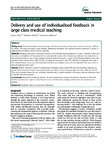Delivery and use of individualised feedback in large class medical teaching
| dc.contributor.author | Burr, SA | |
| dc.contributor.author | Brodier, E | |
| dc.contributor.author | Wilkinson, S | |
| dc.date.accessioned | 2020-07-09T17:37:48Z | |
| dc.date.available | 2020-07-09T17:37:48Z | |
| dc.date.issued | 2013-12 | |
| dc.identifier.issn | 1472-6920 | |
| dc.identifier.issn | 1472-6920 | |
| dc.identifier.other | 63 | |
| dc.identifier.uri | http://hdl.handle.net/10026.1/15962 | |
| dc.description.abstract |
BACKGROUND: Formative feedback that encourages self-directed learning in large class medical teaching is difficult to deliver. This study describes a new method, blueprinted feedback, and explores learner's responses to assess its appropriate use within medical science teaching. METHODS: Mapping summative assessment items to their relevant learning objectives creates a blueprint which can be used on completion of the assessment to automatically create a list of objectives ranked by the attainment of the individual student. Two surveys targeted medical students in years 1, 2 and 3. The behaviour-based survey was released online several times, with 215 and 22 responses from year 2, and 187, 180 and 21 responses from year 3. The attitude-based survey was interviewer-administered and released once, with 22 responses from year 2 and 3, and 20 responses from year 1. RESULTS: 88-96% of learners viewed the blueprinted feedback report, whilst 39% used the learning objectives to guide further learning. Females were significantly more likely to revisit learning objectives than males (p = 0.012). The most common reason for not continuing learning was a 'hurdle mentality' of focusing learning elsewhere once a module had been assessed. CONCLUSIONS: Blueprinted feedback contains the key characteristics required for effective feedback so that with further education and support concerning its use, it could become a highly useful tool for the individual and teacher. | |
| dc.format.extent | 63- | |
| dc.format.medium | Electronic | |
| dc.language | en | |
| dc.language.iso | eng | |
| dc.publisher | Springer Science and Business Media LLC | |
| dc.subject | Feedback | |
| dc.subject | Objective | |
| dc.subject | Assessment | |
| dc.subject | Blueprint | |
| dc.title | Delivery and use of individualised feedback in large class medical teaching | |
| dc.type | journal-article | |
| dc.type | Article | |
| plymouth.author-url | https://www.ncbi.nlm.nih.gov/pubmed/23642040 | |
| plymouth.issue | 1 | |
| plymouth.volume | 13 | |
| plymouth.publication-status | Published | |
| plymouth.journal | BMC Medical Education | |
| dc.identifier.doi | 10.1186/1472-6920-13-63 | |
| plymouth.organisational-group | /Plymouth | |
| plymouth.organisational-group | /Plymouth/Faculty of Health | |
| plymouth.organisational-group | /Plymouth/Faculty of Health/Peninsula Medical School | |
| plymouth.organisational-group | /Plymouth/Users by role | |
| plymouth.organisational-group | /Plymouth/Users by role/Academics | |
| dc.publisher.place | England | |
| dcterms.dateAccepted | 2013-04-29 | |
| dc.identifier.eissn | 1472-6920 | |
| dc.rights.embargoperiod | Not known | |
| rioxxterms.versionofrecord | 10.1186/1472-6920-13-63 | |
| rioxxterms.licenseref.uri | http://www.rioxx.net/licenses/all-rights-reserved | |
| rioxxterms.licenseref.startdate | 2013-05-03 | |
| rioxxterms.type | Journal Article/Review |


